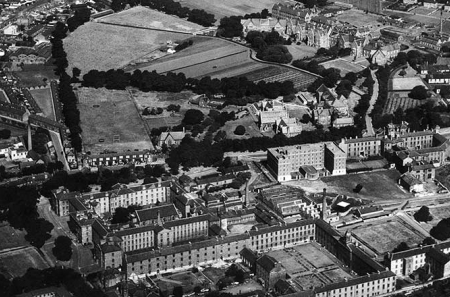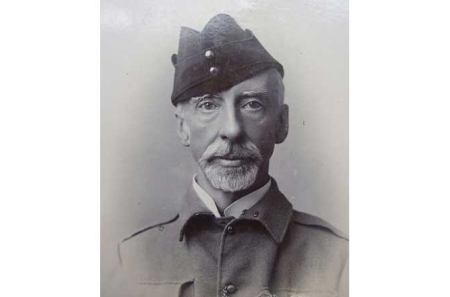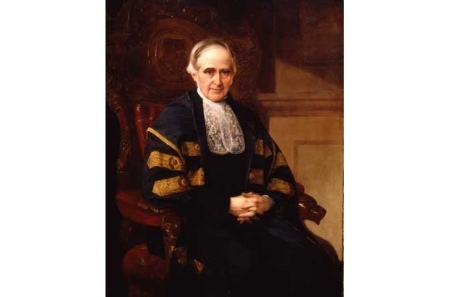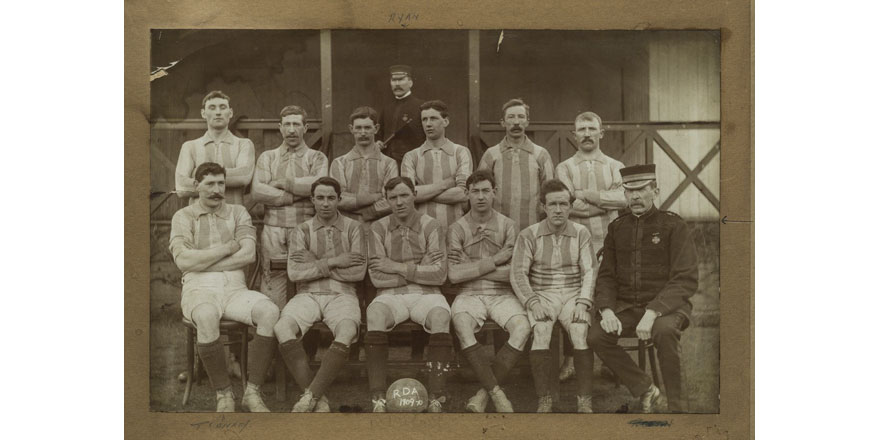
Sport and the Richmond Lunatic Asylum
08 February 2023Downloads
Paul Rouse is a professor in the School of History at University College Dublin. He has written extensively on the history of Irish sport and the global history of sport. In this essay, Paul uncovers the origin and impact of sporting activities at the mental health facilities in Grangegorman.
The history of sport in the Richmond Lunatic Asylum, and its successor the Grangegorman Mental Hospital, in the north inner-city of Dublin, was multi-layered. In the decades immediately after the asylum opened in 1814 sport was not part of the treatment of patients, but, as the nineteenth century progressed, this changed.[1] This essay will examine the nature and extent of that change. It will explore, also, how sport was used in an attempt to present a very particular image of the asylum to the wider world: the Richmond Lunatic Asylum as progressive and compassionate, as an institution where patients were cared for and where they were rehabilitated, or at least treated with dignity.
The essay will also assess the manner in which the asylum developed sporting teams that competed in all manner of local and national competitions. These teams were chosen from among the patients and from the growing numbers of people who worked in the institution; indeed—as was the case with such institutions across the United Kingdom—the sporting opportunities available were one of the attractions of working there.[2] Another aspect of this was that the grounds of the Richmond asylum became a place to play. This was something that transformed the landscape of the institution through the provision of dedicated pitches and other sporting facilities; these facilities saw the asylum eventually function as a venue for sports men and women from outside its walls, as well as for staff and patients. The interlocking relationship between these various aspects of sport created a vibrant sporting culture that evolved in the institution across almost two hundred years.
I
The Richmond Lunatic Asylum initially provided no sport and recreation for its patients. An 1824 report from the inspectors of prisons noted that Richmond was unclean and unpleasant in aspect. In the course of two visits, the inspectors noted how all patients were in their rooms; they deplored the lack of facilities and the fact that access to the garden was extremely restricted.[3] Partly, this absence of recreation and even basic exercise (let alone sport) was a reflection of the overcrowding that was a defining feature of the institution: in 1831, for instance, there were 272 patients resident, but the asylum had just 236 beds. This problem of overcrowding persisted in chronic form through the nineteenth century and for much of the twentieth.[4]
The first meaningful development in respect of exercise for patients at the Richmond Asylum came with the purchase of 16 acres of land from the Earl of Rathdown in 1836. In 1837, a tunnel was built under the road to connect the land with the asylum and 60 male patients were put at work to make a garden. This garden—coupled with the construction of large, open sheds to allow patients to ‘walk and exercise, protected from the rain in winter and the torrid heat of the sun in summer’—allowed convalescent patients some recreational activity.[5] The very ill were not given the same opportunity; the great variation in illnesses experienced by the patients housed in the institution at any one time proved hugely challenging to the creation of an appropriate programme of exercise.
By the second half of the nineteenth century it is clear that many doctors understood—or were coming to understand—the value of exercise, and of recreation in general, as part of treatment for patients in asylums. This was evidenced in the organisation of parties, dances and other forms of entertainment; it is apparent too in the case notes of patients. The realities of the Irish asylum system, however, ensured that this was an uneven experience. This was in part a matter of divergent approaches to finding a balance with the ‘work therapy’ favoured in some regimes, and was conditioned by perceptions of what was appropriate according to class and gender, but it was also a matter of resources.
There were traditions of reading (a library for patients was established at the Richmond Asylum, with a collection of eighteen non-fiction books, in 1844) or playing cards—something that is recorded in the case notes of various patients. There were also isolated references at the Richmond Asylum to patients painting or playing the piano. The most usual form of recreation, however, was to walk in the hospital grounds.[6]
It is not the case that there were no recreational or sporting initiatives; rather that they were not systematic and ordinarily were not pursued with sufficient resources to allow for—as one doctor treating patients at the Richmond Asylum put it—‘curative treatment of the insane’ in the nineteenth century.[7] In short, the mentally ill poor in the public asylum did not enjoy the same access to recreation as those who could afford to pay for private asylum.
In his 1862 book Defects in the moral treatment of insanity in the public lunatic asylums of Ireland, John Blake—a moderate nationalist M.P. and pamphleteer interested in the treatment of mental illness—cited evidence presented to a Royal Commission in Ireland in 1856 about the provision of adequate amusement for patients at Richmond Asylum. Witnesses who spoke to the commission referred to reports and recommendations that proposed significant improvements in the arrangement of recreation, such as billiards, backgammon, chess and draughts, as part of a treatment regime. Some of the witnesses bought such games from their own money, but ‘great improvements are necessary’.[8] Even when resources were committed, things did not run quite as envisioned. For example, a ball-alley was provided but a section of it was then ‘fitted up as a pig-stye for the pigs of the apothecary’.[9]
That ball alley was one of two that were constructed at the asylum in the middle of the nineteenth century, when Samuel Wrigley was in charge. Wrigley told an inquiry in 1857 that the ball courts were used by patients and servants, and that male patients ‘are frequently out playing ball’.[10] This was part of a more concerted effort in the years after the Famine to introduce greater recreational activity for patients. When Dr Joseph Lalor replaced Wrigley and became resident medical superintendent at the Richmond Asylum in 1861, it appears that there was a change of approach; recreation out in the grounds was now firmly encouraged.[11] Lalor wrote in his annual report in 1862 about the provision of football, handball, croquet, darts, bowling and walking for patients. In addition, there were weekly trips to the Phoenix Park, for exercise or to play football, and there was also marching around the Grangegorman grounds in time with the music of the asylum band. While this report most likely exaggerated the place of exercise and sport in the life of the asylum, it nonetheless demonstrates the extent to which it was now at least an aspiration.[12] The western area of the asylum—where the garden for recreation was based—was hugely expanded through the acquisition of more land in the 1860s and it thereafter filled some 57 acres.
Limited advances in the importance attributed to exercise were also evident through the provision of education. There were two national schools—one female, one male—in the Richmond Asylum, governed by a code of rules set down by the state in 1865 for the establishment and regulation of schools in asylums. By 1875 the school-week activities for students included dancing, daily singing classes and the holding of concerts. The closest thing to recreational exercise or sport was ‘marching to music’. A contemporary report noted how ‘a number of patients who marched through the rooms in military order showed how carefully they had been drilled’. This idea of drill was commonplace across the Irish national school system, and for almost all schoolchildren was their only organised physical exercise through the curriculum. Visitors to the schools in the Richmond Asylum on Thursday, 12 August 1875, noted the activities for the day, and as well as formal academic classes, 15 minutes were set aside at 3.45pm for ‘physical exercises, marching, &etc.’ to conclude the school day. These were followed by a rendition of ‘God Save the Queen’.[13]
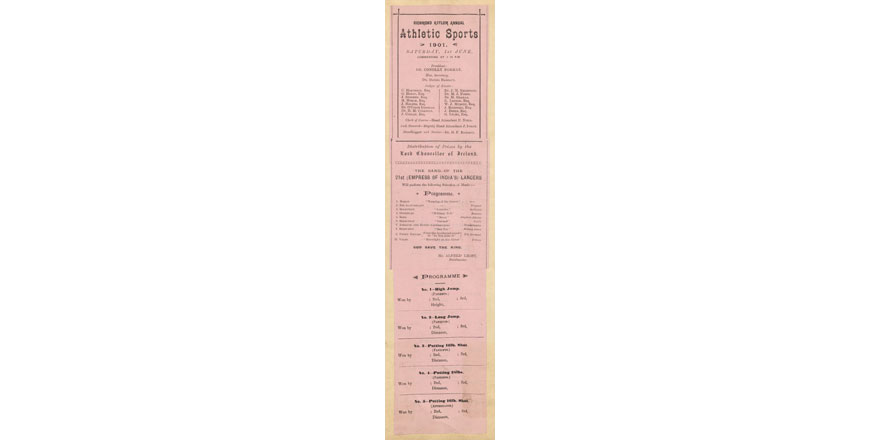
Programme for the Richmond Asylum Annual Athletic Sports, 1 June 1901.
(National Archives of Ireland Priv 1223/22/16/0007-1. Courtesy of the HSE.)
II
Sport in the Richmond Lunatic Asylum was about much more than the treatment of patients, however. By the mid-1860s, by which time there were more than 1,000 patients, an annual Sports Day was a vital part of the activities of the asylum. The idea of a formally organised sports day was something that had begun to take hold in Ireland in the 1850s, and by the 1870s it was something that was commonplace in country towns and in the activities of many institutions. The Richmond Lunatic Asylum was one of the first institutions in the country to have its own Sports Day. As was usual at the time, the day generally involved running, jumping and throwing competitions; novelty contests such as three-legged- and sack- races; as well as sideshows and musical entertainment, provided in this instance by bands of the British army. The Irish Times reported in 1872 that the previously mentioned Dr Lalor was ‘one of the first’ to recognise the value of such activities. It noted that the Sports Day was part of the ‘curative process which has been found so strongly beneficial in working upon the mind of the insane’. The newspaper welcomed the event, saying it was a great change from ‘blows and stripes, impalement by a stake, and [being] obliged to subsist on the lowest diet upon which the human frame could be sustained’.[14]
This newspaper article—and many others in this style—evidenced another purpose to the annual Sports Day that extended beyond the provision of useful recreation to and entertainment of patients; the Richmond Asylum was engaged also in acts of propaganda. There was reference to the huge crowds, to the presence of many local benefactors and philanthropists (with up to 1,000 people invited every year), and to the happy appearance of the patients, who were presented as evidence that the approach to care undertaken in the institution was working.[15] By 1882, it was being reported that:
All the inmates evinced the keenest pleasure in the sports, and showed by their appearance the care and judiciousness of their treatment. Indeed, so far as the results yesterday could afford any testimony, the system—known as the non-restraint system—pursued in this institution seems fraught with all that is most beneficial to the insane.[16]
For all that there was an obvious attempt to present a particular face to the public, it is nonetheless also clear that the programme of events was designed for both men and women patients to compete. There was running and walking racing, weight-throwing, handball matches and a wheelbarrow race. Money prizes, as well as neckties, tobacco, brooches and handkerchiefs, were awarded. The sports day concluded with a concert given by patients, and then a dance that lasted until almost midnight.[17]
This series of events was repeated year-after-year until well into the twentieth century. It was funded by subscriptions and saw hundreds of people come again and again to Grangegorman. It was something that gave a focus to activities within the institution for months in advance, and its importance was outlined in 1897 by Dr Conolly Norman, the then resident medical superintendent:
Our annual sports are a great break in the monotony of our lives, and have a very useful influence, bringing us all together in the pursuit of harmless and healthy entertainment, and in showing our friends outside that our work is not all sombre.[18]
For all that this was true, it is difficult to escape Melinda D. Grimsley-Smith’s conclusion:
In the second half of the nineteenth century, more asylums added ball courts, tabletop games, weekly dances, weekly religious worship, occasional concerts, and the like to divert patients’ attention, but for the majority of patients who were physically and mentally able, work was the major feature of their daily routine.[19]
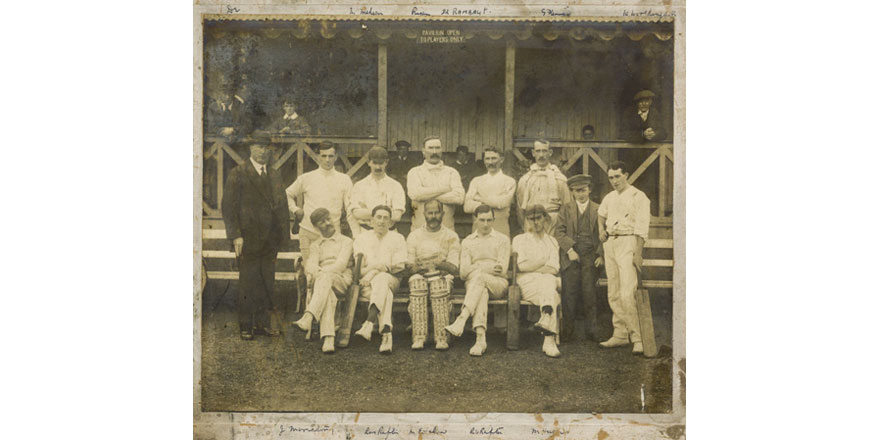
Grangegorman cricket team, circa 1908.
(National Archives of Ireland, Priv 1223/29/93. Courtesy of the HSE.)
III
Sport in the Richmond Asylum was given further impetus by the arrival of Daniel Rambaut as an assistant medical officer in 1893. By then, the modern sporting world with its networks of clubs, associations and governing bodies had emerged as a prominent feature of Irish society. Organised sporting events—whether as part of league or cup competitions, or simply as standalone contests—were becoming increasingly formalised into a calendar of play and were often commercialised. This was a phenomenon that gathered momentum from the 1860s, and by the 1890s it was central to the lives of people all across Ireland, whether in cities or in rural areas, and also encompassed many of the institutions on the island.
The story of this aspect of the organisation of modern sport in the asylum is a reminder too of the importance of the personal interests of key individuals in the operation of institutions. Rambaut was a genuine sporting star. He was an Irish champion hurdler (120 yards) and, more famously, in 1887 was a star player when Ireland defeated England in a rugby match for the first time. He was part of a new generation of rugby players who had replaced ‘old men overladen with the personal heritage and traditions of defeat saturated through them’. The result was a victory that
was a great one. Without going into extravagant metaphors or poetic excursions, it will be hailed with delight by Irishmen all over the globe—from the North Pole to the South Pole, and from the East Pole to the West.[20]
Almost immediately after his arrival at Richmond, Rambaut helped establish teams for soccer and cricket. Later, there were both men’s and women’s hockey teams.[21] These teams appear to have been drawn from among members of staff and they played matches against teams drawn from army regiments and local hospitals and universities. The matches were considered something that ‘would break the monotony of the asylum’ and were in keeping with similar developments in asylums across England.[22] Men who were patients in the asylum also played cricket; this was reported by Dr Conolly Norman in the summer of 1896. He wrote, also, that the fine weather of that summer had in general meant that ‘outdoor amusements of the patients have been carried on very successfully’.[23]
So well organised was the Richmond Asylum cricket club that it was in a position to advertise its calendar of matches for the 1899 season, setting out 17 matches to be played between the end of April and the middle of August against teams from Dublin and Kildare.[24] In 1909 the club was good enough to reach the final of the Junior League Cup.[25] By 1911 the cricket club was playing 35 matches a year, winning 28 of them.[26] In that same year Grangegorman teams were playing in the Leinster Junior Leagues in soccer.[27]
It is during these decades at the end of the nineteenth century and the beginning of the twentieth that formal playing pitches with posts appear to have been laid out at Grangegorman, as part of what were now called the ‘recreation grounds’. These grounds included space for exercise (generally walking) that was segregated by gender. The organised sporting aspect of the activity came to a stop with the outbreak of the Great War in 1914. Sporting organisations active in the grounds of the Richmond Lunatic Asylum essentially ceased all competitive activity across Ireland for the duration of the war. The annual Sports Day at the asylum, which by that point had run for 50 years, was also abandoned.[28] The recreation grounds were later used for sport by British army soldiers during the War of Independence, 1919–21. They had not asked for permission. When the management of the Richmond Asylum objected that this was impinging on the capacity of patients, the army used the Defence of the Realm Act to take possession of the land for the recreation of its soldiers; the men who ran asylum could only protest against ‘the invasion by the military of the patients’ football ground’.[29]

St Dympna’s Hurling Club, Grangegorman, 1935.
(National Archives of Ireland, Priv 1223/29/98. Courtesy of the HSE.)
IV
Richmond Asylum was known as Grangegorman Mental Hospital from May 1921, the change in name coinciding with a revolution that ultimately brought the partition of Ireland. After the establishment of the Irish Free State, sport continued to play a significant role in the institution. The Grangegorman Resident Medical Superintendent, John O’Conor Donelan, said in 1924 that ‘games and sports were of the greatest assistance to the insane’.[30] Dedicated funding was provided on an annual basis for miscellaneous sporting expenses, but as late as the 1940s this amounted to just ‘£300 for outdoor sports and pastimes’, out of a total expenditure of £337,826 for the upkeep of the institution.[31]
The annual sports day returned in the decades immediately after independence. In 1927, for example, despite heavy rain, there was a programme of athletics, cycling and novelty events for patients and staff.[32] The sports days were not what they once had been, however. There was a dispute in 1937 that demonstrated the changing nature of the day. An employee of the institution who had brought his children to the Grangegorman Sports Day was denied admission for them. This led to a discussion at a monthly meeting of the Grangegorman Management Committee, during which the resident medical superintendent said that ‘he would not mind the members’ adult friends attending, but he would not like to encourage the presence of children amongst mental patients’.[33]
In sporting terms, the most significant change was the establishment of a club for Gaelic games. The fact that there was no GAA club established before 1920 is revealing about the cultural preferences (and the politics) of those who ran the institution before the establishment of the Irish Free State. There were divisions that continued to echo. In 1931 at a meeting of the management committee discussing the financial estimates for the year, one member, Luke O’Toole, intervened in respect of the £300 voted for the provision of sport for patients. O’Toole, who was then the most important official in the GAA, said that £150 of the £300 should be ‘devoted to the encouragement of Gaelic games’. This brought the counter-argument that there ‘should be no coercion concerning games’. When another committee member, J. Costello (who falsely claimed that he had attended the founding meeting of the GAA in Thurles in 1884) said he had never been to a soccer match or a rugby match and that Gaelic games should get pride of place, Donelan was moved to intervene. He said that
the main object of games in the institution was the provision of entertainment of patients …. He wanted to see games played, but did not care what class of game it was, and was prepared to support every game without distinction.[34]
In the years that followed, despite the divides suggested in this exchange, Gaelic games thrived alongside those that had been played in the asylum before independence. Much later—in 1980— St Brendan’s, the hurling club playing out of Grangegorman, won the Dublin senior hurling championship. Soccer continued to be important, with teams fielded by men who worked in the institution and by others who played for its teams. These clubs—variously known as Grangegorman Football Club (which in its best years played Leinster Senior League), St Brendan’s Football Club (played in League of Ireland B Division during the 1970s) and Brendanville Football Club (played in the Leinster Senior League until its last game in 2013)—played a calendar of matches that drew some of the best players in the city to the grounds at Grangegorman. Other sports also continued to prosper. Men’s and women’s hockey teams competed through the rest of the century, producing players good enough to play for Leinster and Ireland. A cricket team continued to play out of Grangegorman for decades, while the laying down of ‘a new green with sea-washed turf’ saw the institution’s bowling team competed in the Irish Free State League and its successors across the decades.[35]
There was sport also for patients. This was captured in Paul Durcan’s poem ‘Sport’:
On my twenty-first birthday
I was selected to play
For Grangegorman Mental Hospital
In an away game
Against Mullingar Mental Hospital.
I was a patient
In B Wing.
What sporting contests also demonstrated, however, was the manner in which the Grangegorman Mental Hospital—as the Richmond Asylum before it—had created a closed world. For example, requests by various local sports clubs to use the grounds for matches during the middle decades of the twentieth century ‘were always refused’.[36]
Through these decades—year after year—the scale of overcrowding had a crushing effect on the capacity to provide recreation for patients. Although exercise in the grounds (including sport) was something that could be offered to convalescent patients, for those who were seriously ill there was a different approach. It was acknowledged time and again that exercise—even physical drilling and marching—would have benefit for all patients; the reality, however, as was reported in the 1930s, was that ‘until the overcrowding was reduced and a new recreation hall built, the question of introducing drill for demented and imbecile patients would have to remain in abeyance’.[37]
The Report of the Commission of Inquiry on Mental Illness (1966) noted that
properly organised recreational activities should be available in every hospital. It should be clearly recognised that recreation is not provided merely for the amusement and entertainment of patients, but is an important part of their treatment.[38]
This was seen not just as a matter of physical exercise, but also as something that should be regarded as useful for patients, who would engage in the planning and organisation of activities. Moreover, it was not to be confused with the activities of those patients who are ‘observed walking aimlessly around a recreation ground’.[39] Delivery of this ambition, however, was deeply compromised by overcrowding and under-resourcing.
V
In the latter decades of the twentieth century and into the twenty-first, the development of community-based mental health services diminished the number of patients living in Grangegorman Mental Hospital. In the 1940s there had been more than 2,000 patients in Grangegorman at any one time; by the mid-1980s that had fallen to under 1,000 and the number continued to fall into the new millennium. By the time the last patients in the hospital were transferred to the Phoenix Care Centre and the site ceased to function as a mental hospital in 2013, the place of sport had been transformed. The cricket and hockey clubs were gone; the GAA club had slipped down the divisions in Dublin; and the sporting infrastructure in the site had fallen into decay.
The old ball alleys were demolished, as was the pavilion used by the cricket and hockey teams. The GAA and soccer pitches were torn up to be remade for the students who would soon be arriving from the constituent colleges of the Dublin Institute of Technology (later renamed the Technological University of Dublin). What remained were the trees that had been sown around the walkways that had been used for more than a century for exercise by patients and staff. New pitches—some grass, others artificial turf—were set out around the old recreation grounds, tennis courts were built, and an all-weather surface for basketball was constructed. Two table-tennis tables were installed on the stone passageway through the middle of the expanding campus. A modern gym was fitted out in buildings once used to house patients. It was a reminder of the centrality of sport and sporting practices to modern Ireland.
When the Richmond Lunatic Asylum opened at the beginning of the nineteenth century, the organisation of sport was slowly assuming its modern form. This was a process that coincided with the development of the asylum system in Ireland. During the nineteenth century—and especially in its latter decades—sport became part of the life of the Richmond Lunatic Asylum and of many patients and members of staff; it influenced the landscape of the asylum. This process continued through the twentieth century as the number of patients in Grangegorman continued to grow, before declining precipitously in the last decades of that century. Sport—as part of a revised, broader approach to recreation and exercise—became fundamental to the story of the institution.
[1] The institution was variously known as the Richmond Lunatic Asylum, the Richmond District Lunatic Asylum, Grangegorman Mental Hospital and St Brendan’s Mental Hospital.
[2] Steven Cherry and Roger Munting, ‘“Exercise is the thing”? Sport and the asylum c. 1850–1950’, International Journal of the History of Sport 22 (1) (2005), pp 42–58.
[3] Joseph Reynolds, Grangegorman: psychiatric care in Dublin since 1815 (Dublin, 1992; Institute of Public Administration), p. 39.
[4] Reynolds, Grangegorman: psychiatric care, p. 47. See, also, E. Margaret Crawford, ‘A mystery malady in an Irish asylum: the Richmond epidemic of the late nineteenth century’, in Pauline M. Prior (ed.), Asylums, mental health care and the Irish, 1800–2010 (Dublin, 2012; Irish Academic Press), pp 185–204.
[5]Reynolds, Grangegorman: psychiatric care, p. 53.
[6] Alice Mauger, The cost of insanity in nineteenth-century Ireland: public, voluntary and private asylum care (London, 2018; Palgrave Macmillan), pp 195–8.
[7] John Blake, Defects in the moral treatment of insanity in the public lunatic asylums of Ireland (Waterford, 1862; The Citizen), pp 20–21.
[8] Blake, Defects in the moral treatment of insanity, pp 20–23.
[9] Blake, Defects in the moral treatment of insanity, pp 20–22.
[10] Reynolds, Grangegorman: psychiatric care, p. 113.
[11] Brendan Kelly, Grangegorman histories: inside the asylum (Forthcoming; Dublin: Royal Irish Academy).
[12] Reynolds, Grangegorman: psychiatric care, p. 136.
[13] D. Hack Tuke, ‘On the Richmond Asylum Schools’, Journal of Mental Science, 21 (95) (1875), pp 467–74
[14] Anon., 'Richmond District Lunatic Asylum', The Irish Times, 23 August 1872, p. 5.
[15] . Anon., 'Richmond District Lunatic Asylum', The Irish Times, 23 Aug. 1872, p. 5.
[16] Anon., 'Annual sports at Richmond Asylum', The Irish Times, 8 September 1882, p. 7.
[17] Anon., 'Richmond District Lunatic Asylum', The Irish Times, 23 August 1872, p. 5.
[18] Anon., 'Richmond Asylum Sports', The Irish Times, 12 June 1897, p. 9.
[19] Melinda D. Grimsley-Smith, Politics, professionalization and poverty: lunatic asylums for the poor in Ireland, 1817-1920. Unpublished Ph.D. thesis. University of Notre Dame, 2011.
[20] Anon., 'Rugby', Sport, 12 February 1887, p. 2.
[21] Anon., 'Hockey', The Irish Times, 3 December 1909, p. 4 and 16 April 1927, p. 17.
[22] Cherry and Munting, '"Exercise is the thing"?' pp 42-58 and Aidan Collins, 'Daniel Frederick Rambaut: "Rugbanian" and innovative Resident Medical Superintendent', Irish Journal of Psychological Medicine 34 (2017), pp 75-8.
[23] National Archives of Ireland, Richmond District Asylum Minute Books, 'Report of Dr. Conolly Norman, 1896', pp 99-101.
[24] Anon., 'Richmond Asylum', The Irish Times, 22 April 1899, p. 5.
[25] 'Notes on Sport', The Irish Times, 11 September 1909, p. 23.
[26] Anon., 'Cricket', The Irish Times, 21 September 1911, p.5.
[27] Anon., 'Sport', The Irish Times, 23 September 1911, p. 21.
[28] Reynolds, Grangegorman: psychiatric care, p. 223.
[29] Reynolds, Grangegorman: psychiatric care, p. 223.
[30] Anon., 'From day to day', The Anglo-Celt, 27 December 1924, p. 3.
[31] Anon., 'Mental Hospital upkeep estimated at £337,826', The Irish Times. 7 January 1946, p. 6. It should be noted that this £300 does not include the amount of money spent on the daily upkeep pf the grounds and facilities.
[32] Anon., 'Grangegorman Mental Home. Rain curtails annual sports programme', Sunday Independent, 14 August 1927, p. 13.
[33] Anon., 'Grangegorman', Drogheda Independent, 26 June 1937, p. 13.
[34] Anon., 'Grangegorman Hospital estimate of £208,504', The Irish Times, 5 February 1931, p. 8.
[35] Anon., 'Bowling: the Free State League', The Irish Times, 16 January 1936, p. 11.
[36] Reynolds, Grangegorman: psychiatric care, p. 22.
[37] Reynods, Grangegorman: psychiatric care, p. 258.
[38] Report of the Commission of Inquiry on Mental Illness (Dublin, 1966; Stationery Office), p. 89.
[39] Report of the Commission of Inquiry on Mental Illness (1966), p. 97.
Artcile opening image: Grangegorman soccer team, 1909–10. (National Archives of Ireland, Priv1223/29/96. Courtesy of the HSE.)

